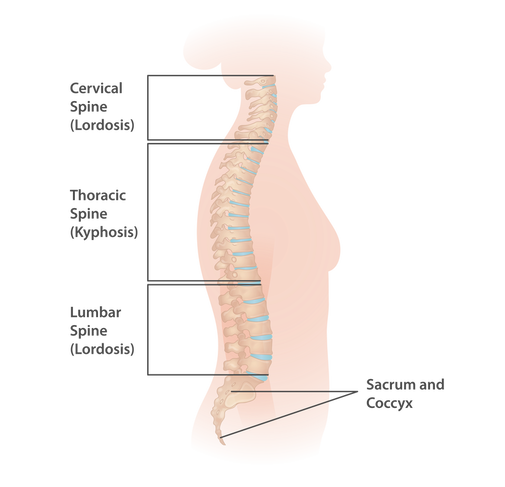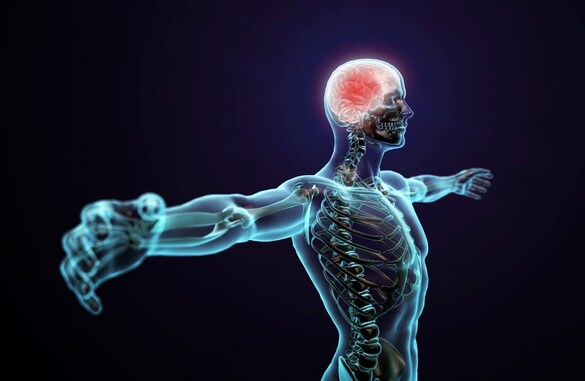 The Spine: What it is & Why it's Important The word spine typically refers to both the vertebral column and the spinal cord. The spinal cord starts at the base of the brain and runs through the vertebral column, a flexible pillar of approximately 33 bones that houses the spinal cord for protection. Approximately because some lower vertebrae can fuse together over time. This column encases the spinal cord, a nerve network containing 31 nerve pairs that send information to initiate movement and action and receive stimuli to react and respond in the world. The spinal cord floats in cerebrospinal fluid (CSF), a unique water-based conductive liquid that envelopes and protects it. The spine is the most important structure in the body because we can't move without it and all major functions are done through it. The nerves that run through it and to the rest of the body are critically important for motor function and recruitment, and without that, we are immobilized. When you think about it, you can't do anything without a functional and healthy spine. Bending over, twisting, reaching, and leaning all require some degree of spinal flexion, extension, rotation, or lateral flexion. CNS & PNS: The Body's Orchestra The central nervous system is the conductor to the orchestra that is the complex collection of nerve networks, neurons, and all other major and minor bodily functions that make life happen. It primarily resides in the spinal column, where it then branches out into the peripheral nervous system, the portion of the nervous system that enacts movement and receives environmental stimuli for response and reactions. If the CNS is the conductor, the PNS is the band where the neurons listen and make the music. Thirty one pairs of nerves stem from the spine, starting at the cranial and cervical nerves running all the way down this nervous superhighway to the lumbar and sacral nerves. This complex and deeply interwoven series of nerves is critical to proper functioning of any kind; this is why neurodegenerative and neurological diseases are so pernicious. Any damage done to the spine can be life altering forever. Common Postural Distortions Major institutions, such as Stanford Health, are going as far to say that "sitting is the new smoking." Why? Because a sitting lifestyle is a sedentary lifestyle; a sedentary lifestyle is an unhealthy lifestyle. Imagine this all-too-common scenario: A man wakes up for the day. He gets his coffee and sits to check his emails. After that, he sits in his car to go to work. When he gets to work, he sits at his desk. Maybe he'll go out for lunch and sit with friends. When he gets home he sits at the couch for some TV time and/or at at the table for dinner. Sitting won't literally kill you--but sitting 50+ hours a week, every week of the month, every month of the year might. Worse yet is the postural distortions that occur from this. The spine has three natural curves to it, called the cervical, kyphotic, and lordotic. We'll skip the latin, but basically these are the natural curves that give the spine that S shape. When these curves get too severe, though, postural distortions occur, like kyphosis and lordosis. These can worsen over time if uncorrected. Kyphosis, Lordosis, Upper & Lower Crossed Syndrome Let's go back to our sitting man. This man who sits (and doesn't sign up at Evolve Fit Studios) will eventually develop kyphosis, an over-curving of the spine. This will lead to upper crossed syndrome, or the shortening of anterior (front) muscles, which can lead to a host of issues including but not limited to shoulder pain or impingement, a tight or stiff neck, and back pain. If not corrected and he goes to lift something heavy without right mechanics, he can throw out his back and have problems for a lifetime. Don't be the sitting man. Lordosis, on the other hand, can be considered the inverse. Again, sitting will exacerbate this natural curve. Prolonged sitting will lead to inactive glutes, making them weak, which the body will compensate for in other ways. This might create tight quads, pulling down the pelvis and making that lower lordotic curve more severe, leading to pinched nerves, back pain, hip pain and more. So get up and move! Technique & Lifestyle > This sitting man is an extreme example to illustrate a point. A healthy lifestyle with walking, cardio, and a functional fitness program (created by a stellar trainer at Evolve) will combat the worst of these harms. The most important thing to keep in mind is movement often and to exercise the full range of your body's abilities. The old adage, "if you don't use it, you lose it" is a very real maxim when it comes to the body. Engage your core properly, hire a trainer if you're not confident in your technique, and don't skip out on your workouts. Our body was built to move and move well, so get out there and move some dumbbells! (properly ;) ps: lots of clean water with electrolytes will keep that CSF lubricated and conductive for a right functioning CNS for all your days tasks, cognitive, movement, or otherwise. -- I hope this brief piece on spine health taught you something you didn't know about the spine and how important it is to move often and properly. Taking care of our spine is the most important thing we can do when engaging in lifting of any kind.
0 Comments
|
Evolve Fitness StudiosCheck out posts from our trainers, healthy recipes, and tips for staying motivated and more! Categories
All
|


 RSS Feed
RSS Feed
